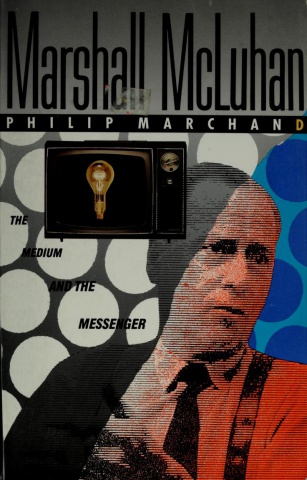Philip Marchand: Marshall McLuhan: The Medium and the Messenger (1989)
Filed under book | Tags: · advertising, biography, communication, mass media, media, media theory, print, radio, religion, technology, television

He was described as “the greatest put-on artist of all time” and even as the greatest intellectual pioneer since Freud. Bouncing back and forth between the quiet University of Toronto campus and the glitzy world of the New York media, McLuhan was surely the most unlikely prophet of the sixties, yet his work underlies any serious discussion of the effects of media on our lives. (from the back cover)
Publisher Ticknor & Fields, New York, 1989
ISBN 0899194850
320 pages
Review (Christopher Lehmann-Haupt, The New York Times Books, 1989)
Review (E. Hamilton, Canadian Literature, 2001)
Review (Robert McKenzie, IPCT, 1994)
Review (William H. Melody, Information, Communication & Society, undated)
PDF (50 MB, no OCR)
Comment (0)Letters of Marshall McLuhan (1987)
Filed under book | Tags: · biography, communication technology, language, literary theory, mass media, media, media theory, print, technology, television

McLuhan corresponded with a vast number of people, including Duke Ellington, Woody Allen, Jacques Maritain, Rollo May, Susan Sontag, Eugene Ionesco, Wyndham Lewis, Ezra Pound, Bob Newhart, Hubert Humphrey and Jimmy Carter.
Heavily annotated, the letters are arranged in three sections, each with a period introduction: 1931-1936 takes McLuhan through the University of Manitoba and Cambridge University. 1936-1946 covers one year’s teaching at the University of Wisconsin; two years at Saint Louis University; one year, with his bride, at Cambridge for work on his Ph.D.; four more years at Saint Louis; and two years as Assumption College, Windsor, Ontario. These letters include a large correspondence with Wyndham Lewis. The last section begins in 1946, when McLuhan went to the University of Toronto. Two years later he began a long correspondence with Ezra Pound. Covering the period of McLuhan’s fame, it ends in September 1979 with a letter to Pierre Elliott Trudeau, written shortly before McLuhan had a stroke that rendered him speechless.
These letters have been selected from a large collection, now in the Public Archives of Canada, and offer a valuable commentary on McLuhan’s work and, in some instances, the most lucid and detailed explanation of his ideas available.
Selected and edited by Matie Molinam, Corrine McLuhan, and William Toye
Publisher Oxford University Press, 1987
ISBN 0195405943
562 pages
Review (R.D. Berg, Canadian Journal of Communication, 1988)
Review (Frank Kermode, London Review of Books, 1988)
PDF (189 MB, no OCR, any help in reducing the size is welcome!)
Comment (1)Leshu Torchin: Creating the Witness: Documenting Genocide on Film, Video, and the Internet (2012)
Filed under book | Tags: · documentary film, documentary photography, film, genocide, holocaust, human rights, internet, mass media, photography, politics, television, video

“Since the beginning of the conflict in 2003, more than 300,000 lives have been lost in Darfur. Players of the video game Darfur Is Dying learn this sobering fact and more as they endeavor to ensure the survival of a virtual refugee camp. The video game not only puts players in the position of a struggling refugee, it shows them how they can take action in the real world.
Creating the Witness examines the role of film and the Internet in creating virtual witnesses to genocide over the past one hundred years. The book asks, how do visual media work to produce witnesses—audiences who are drawn into action? The argument is a detailed critique of the notion that there is a seamless trajectory from observing an atrocity to acting in order to intervene. According to Leshu Torchin, it is not enough to have a camera; images of genocide require an ideological framework to reinforce the messages the images are meant to convey. Torchin presents wide-ranging examples of witnessing and genocide, including the Armenian genocide, the Holocaust (engaging film as witness in the context of the Nuremburg trials), and the international human rights organization WITNESS and its sustained efforts to use video to publicize human rights advocacy and compel action.
From a historical and comparative approach, Torchin’s broad survey of media and the social practices around it investigates the development of popular understandings of genocide to achieve recognition and response—both political and judicial—ultimately calling on viewers to act on behalf of human rights.”
Publisher University of Minnesota Press, 2012
Visible Evidence series, Volume 26
ISBN 0816676224, 9780816676224
296 pages
Author’s discussion of the book
Publisher
PDF (updated on 2021-1-24)
Comments (3)
